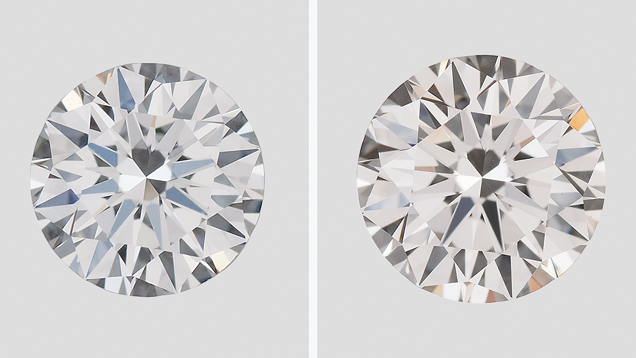CVD vs HPHT Lab Grown Diamond. The difference explained
Education Source www.gia.edu
https://www.gia.edu/gia-news-research-improved-quality-identification-challenges
Synthetic Diamonds: Improved Quality and Identification Challenges

CVD synthetic diamonds began appearing in the gem diamond market about a decade ago. The process involves introducing a gas, such as methane, into a vacuum chamber, then activating and breaking down the molecules of the gas with microwaves. This causes the carbon atoms to accumulate on a substrate (a small platform containing a flat diamond seed crystal, usually an HPHT synthetic), similar to the way snowflakes accumulate in a snowfall.
The HPHT method, first used to successfully grow diamonds by General Electric in 1954, essentially mimics the natural process - carbon is crystallized as diamond through intense heat and pressure deep within the Earth. The HPHT process is very costly, given the energy and equipment required, and produces diamonds with mainly yellowish or brownish yellow colors.
The CVD method is much less costly because it works at moderate temperatures and low pressure, which requires smaller and less expensive equipment. Because the vacuum chamber contains only carbon and some hydrogen, colorless crystals can be grown. If nitrogen or boron is introduced into the chamber, yellow or blue synthetic diamond crystals can be produced.
At first, the creators of these CVD diamonds thought they would be able to produce diamonds quickly and cheaply. However, because the quality was inconsistent and the typical brown colors were less than desirable, those expectations were not met.
In the past decade, CVD producers have found that changing the gases in the growth chamber and using a purer Type II synthetic diamond as a seed crystal can improve the color of the finished synthetic diamond and speed the growth rates. Since many early CVDs had a brownish color, producers also found that treating the material at high temperatures and pressures can remove the brown coloration to make the crystals colorless. This treatment step masked some of the signature features, which resulted in the identification of these synthetic diamonds becoming more difficult.
The Gemesis Corporation of Sarasota, Florida, which produced its earlier synthetic diamonds with the HPHT-process, began to market colorless CVD synthetic diamonds in March 2012. There are several other companies which also sell CVDs.
GIA researchers purchased 16 CVD diamonds from Gemesis, 15 of them cut into round brilliants, ranging from 0.24 carats to 0.86 carats. The majority had very high colors, ranging F-G on the GIA 4Cs scale. Three were I-J. The largest, at 0.90 carats, was a rectangle cut graded L, since it showed a slight yellowish cast.
The researchers, led by Dr. Wuyi Wang, GIA’s director of research and development, subjected these synthetic diamonds to an extensive battery of tests. The tests included several sophisticated types of spectral analysis to obtain a telltale “signature” of samples created by the CVD process. By using advanced instrumentation, scientists can read the diamonds’ spectral signature to determine their composition, or whether they originated in nature or a laboratory. The GIA researchers also conducted standard gemological tests, including checking for features known to be diagnostic for other synthetic diamonds, such as graining patterns and ultraviolet fluorescence reactions. Diamonds have a grain, like wood, that is a result of the way they crystallize, but because they grow differently in nature than in a lab, the grain patterns of synthetic diamonds are different.
The GIA tests found that the quality of colorless to near-colorless CVD-grown diamonds has improved significantly in the decade since they were introduced. In the past, CVD synthetics displayed graining patterns not found in natural diamonds, as well as distinctive fluorescence reactions. These samples showed that separating such stones from natural diamonds requires the use of advanced spectroscopic techniques. In addition, it was apparent that the synthetics were treated under high heat to remove or obscure some of their telltale features, such as graining which, after treatment, is very difficult to see.
Despite the difficulty in spotting these stones by conventional means, GIA researchers did find unique spectroscopic signatures. They did so by subjecting photoluminescence and ultraviolet fluorescence reactions to the DiamondView™, a sophisticated instrument used by gemological labs to detect synthetic diamonds.
GIA continues to make synthetic diamonds a top research priority so it can identify and report on the latest developments of these lab-created stones.
